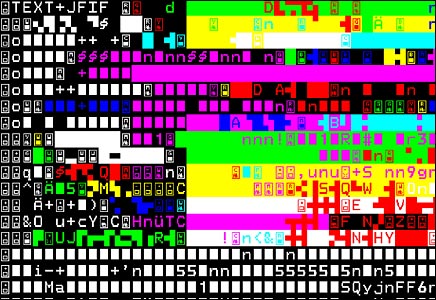
Jodi.org, created as a dual project between Joan Heemskerk and Dirk Paesmans, is a prime example of conceptual art of the new media persuasion. Other projects and artists of my concentration have been wholly performance or idea-based, the web becoming the main means of disseminating that idea or situation, though containing no real visual content of its own. Although the work contained in Jodi.org is certainly unorthodox, it reflects a certain return to previous creations in that its visual aspects, as coupled with the behind-the-scenes aspects of thought process, contain meaning to better the viewer’s understanding of the work. When one enters the main website wwwwwwwww.jodi.org (as addressed by the Mark Tribe directory), one is confronted with a mess of text and image in occurring in varying sizes and overlapping without any apparent order. Some of the text or image links to a different page, which displays new patterns of broken script, image, animation and line. It is recognizable that these websites seem to be distortions of typical ones, a representation of one that loads poorly no matter how many times the page is refreshed. One feels as though they are feeling a path through the dark from one unknowable location to another.
All web users have experienced a glitch at some point; sometimes even common pages like Facebook display temporary glitches where the orderly, gridded content of the network is distorted and expressed in different fonts, sizes and arrangements. I find myself weirdly terrified of glitches, or so classically-conditioned to click “back” or “refresh” when I experience one that I experience a mild wave of dread and displeasure when I see one. We want the internet to be a clear, organized, unfailing container of information and to be a portal to other sources of clear information, so the speed and alacrity of our reception of new image and information is second only to our thought processes; this desire to “assert” (or at least expect) order over this tool demands that we despise any and all problems that may arise. This keeps us from appreciating the intrigue and (dare I say it?) beauty in a poorly loaded page, in disorder in the realm of order. The website itself, if seen in HTML form, has a pictograph of a hydrogen-bomb tucked within the otherwise-accurate code: thus, the action of the makers to create this disorder by planting a literal (in its pictorial form) and figurative (in the form of its translation to HTML’s language) bomb in the code was quite deliberate. Although the exact outcome of any given website with an encoded “bomb” was surely unknown to Heemskerk and Paesmans, the exact outcome is not as important as the act of distortion and the result that one experiences emotionally and cognitively when feeling their way through the website.
For me, this project emphasizes the abstract quality of the internet: although what we see in a website is a projected image, a space in which we literally move around (with a mouse or keyboard) and navigate within, it has been created based on a gobbledygook (as perceived by the untrained reader) of text and symbol , or simply of 1’s and 0’s. In essence, the internet is like an illusionistic painting: it may be created of paint, a raw material that simply has color, but that is meticulously arranged to create an image that appears to be like real life, and able to be interacted with. However, as painting progressed, intentional defects in the application of paint (such as abandoning perspective, life observation, etc) led to the creation of paintings that acknowledged the media behind it and shattered the illusionistic aspect that many modern artists felt distracted from the idea behind work. Jodi.org does for virtually-realistic websites what abstraction did for painting: it forces the viewer to realize the material behind it, and the aesthetic possibilities therein. Personally, I find the ability to observe a glitch as not only mildly emotionally jarring, but exciting: the colors, the new patterns, the almost-humorous absurdity is very eye-pleasing, in a way that few new media artists allow their work to be.
No comments:
Post a Comment